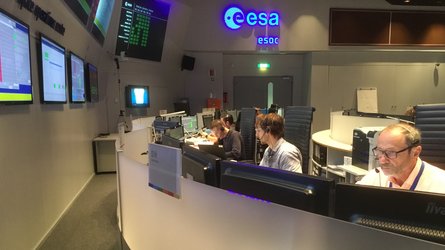Accept all cookies Accept only essential cookies See our Cookie Notice

About ESA
The European Space Agency (ESA) is Europe’s gateway to space. Its mission is to shape the development of Europe’s space capability and ensure that investment in space continues to deliver benefits to the citizens of Europe and the world.
Highlights
ESA - United space in Europe
This is ESA ESA facts Member States & Cooperating States Funding Director General Top management For Member State Delegations European vision European Space Policy ESA & EU Space Councils Responsibility & Sustainability Annual Report Calendar of meetings Corporate newsEstablishments & sites
ESA Headquarters ESA ESTEC ESA ESOC ESA ESRIN ESA EAC ESA ESAC Europe's Spaceport ESA ESEC ESA ECSAT Brussels Office Washington OfficeWorking with ESA
Business with ESA ESA Commercialisation Gateway Law at ESA Careers Cyber resilience at ESA IT at ESA Newsroom Partnerships Merchandising Licence Education Open Space Innovation Platform Integrity and Reporting Administrative Tribunal Health and SafetyMore about ESA
History ESA Historical Archives Exhibitions Publications Art & Culture ESA Merchandise Kids Diversity ESA Brand Centre ESA ChampionsLatest
Space in Member States
Find out more about space activities in our 23 Member States, and understand how ESA works together with their national agencies, institutions and organisations.
Science & Exploration
Exploring our Solar System and unlocking the secrets of the Universe
Go to topicAstronauts
Missions
Juice Euclid Webb Solar Orbiter BepiColombo Gaia ExoMars Cheops Exoplanet missions More missionsActivities
International Space Station Orion service module Gateway Concordia Caves & Pangaea BenefitsSpace Safety
Protecting life and infrastructure on Earth and in orbit
Go to topicAsteroids
Asteroids and Planetary Defence Asteroid danger explained Flyeye telescope: asteroid detection Hera mission: asteroid deflection Near-Earth Object Coordination CentreSpace junk
About space debris Space debris by the numbers Space Environment Report In space refuelling, refurbishing and removingSafety from space
Clean Space ecodesign Zero Debris Technologies Space for Earth Supporting Sustainable DevelopmentLatest
Applications
Using space to benefit citizens and meet future challenges on Earth
Go to topicObserving the Earth
Observing the Earth Future EO Copernicus Meteorology Space for our climate Satellite missionsCommercialisation
ESA Commercialisation Gateway Open Space Innovation Platform Business Incubation ESA Space SolutionsLatest
Enabling & Support
Making space accessible and developing the technologies for the future
Go to topicBuilding missions
Space Engineering and Technology Test centre Laboratories Concurrent Design Facility Preparing for the future Shaping the Future Discovery and Preparation Advanced Concepts TeamSpace transportation
Space Transportation Ariane Vega Space Rider Future space transportation Boost! Europe's Spaceport Launches from Europe's Spaceport from 2012Latest

Mission control is GO for Euclid launch
Thank you for liking
You have already liked this page, you can only like it once!
No ESA mission can fly until the pre-launch briefing is complete and we have the all important group photo. This is the team that will fly Euclid and settle it into its new home in space, all the while ensuring its safety and the functioning of its extremely sensitive instruments, allowing it to peer ten billion years back in time to the early Universe.
Briefing complete, mission control is GO for launch.
On Tuesday afternoon, teams at ESA’s mission control centre in Darmstadt, Germany, completed another final crucial step in the run up to the launch of ESA’s Euclid space telescope: the dress rehearsal.
After months of simulations, the team at mission control brought together the various Euclid partners and the spacecraft itself, for the final fully integrated rehearsal before launch.
The rehearsal is a live re-enactment of the 'network countdown', where teams run through every step that takes place on launch day - every word spoken, every confirmation given, every button pressed.
"The dress rehearsal went very well. It was a joint exercise between the teams at ESA, the spacecraft manufacturer Thales Alenia Space, and all the teams in Florida. The rehearsal involved communicating between the real ground stations and operational systems and facilities that we will use for Euclid's launch and early orbit phase (LEOP)," says Euclid Flight Director Andreas Rudolph. "Overall, another important successful step towards the big day."
Euclid is scheduled to launch from Cape Canaveral Space Force Station in Florida, USA, on a SpaceX Falcon 9 launcher on 1 July at 17:12 CEST.
After launch, ESA mission control will perform a trajectory correction manoeuvre to guide Euclid through its journey to ‘Lagrange point 2’ - one of five points around the Sun and Earth where the gravitational forces between the two bodies balance out, creating gravitational ‘plateaus’ around which objects can orbit, stably, without too much work to keep them in place.
There, ESA's new cosmic detective will join the Agency's Gaia telescope and the NASA/ESA/CSA James Webb Space Telescope. From an average distance of 1.5 million km from Earth, it will send back a record amount of data back via ESA’s Estrack network of ground stations across the globe about details on the early Universe and its evolution.
Follow @esa, @esaoperations, @esascience and @esa_euclid for live updates of the Euclid launch.
-
CREDIT
ESA -
LICENCE
ESA Standard Licence

Euclid's twin arrives at mission control - set-up complete

ESOC teams complete BepiColombo dress rehearsal

Euclid's twin arrives at mission control - training

Sentinel-2C mission control team photo















 Germany
Germany
 Austria
Austria
 Belgium
Belgium
 Denmark
Denmark
 Spain
Spain
 Estonia
Estonia
 Finland
Finland
 France
France
 Greece
Greece
 Hungary
Hungary
 Ireland
Ireland
 Italy
Italy
 Luxembourg
Luxembourg
 Norway
Norway
 The Netherlands
The Netherlands
 Poland
Poland
 Portugal
Portugal
 Czechia
Czechia
 Romania
Romania
 United Kingdom
United Kingdom
 Slovenia
Slovenia
 Sweden
Sweden
 Switzerland
Switzerland

























